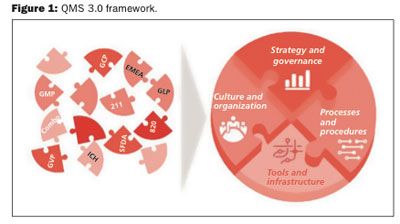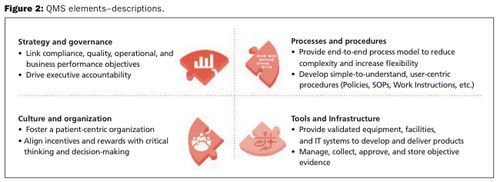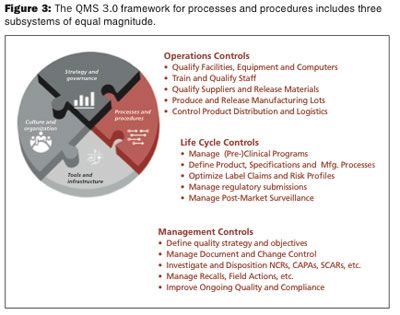A Next Generation of Quality Management
The author proposes a quality management system that uses the power of executive management to promote a positive quality culture.

When a biopharmaceutical and life-sciences (PLS) company encounters a quality issue, FDA warning letters and consent decrees are usually addressed directly to the chief executive officer (CEO), explicitly placing the responsibility for quality with the head of the organization. The typical PLS CEO, however, has neither the background nor the tools available to sufficiently address quality--especially at the level of regulatory oversight. Responsibility in the absence of tools or background is a precarious position that the PLS industry needs to meet head on.
At its core, this situation stems from the historical fact that the life-sciences industry often perceives quality management systems (QMS) as compliance-driven rather than as an effective process to realize continuous improvement in product and process quality. This was the case dating back to 1987, when the International Organisation for Standardisation (ISO) developed the original QMS framework--ISO 9000. While the PLS industry never fully embraced ISO 9000, over time different regulatory agencies in the PLS space created various QMS frameworks to fit their own purposes.
In this environment, current QMS standards have not kept pace with a growing variety of products and technological complexity. In many instances, the high cost of change and the associated regulatory approvals deter companies from implementing quality improvements. Further complicating matters, companies typically have separate quality management systems across the GxP lifecycle spectrum and, because of acquisitions, across divisions as well. As a result, current QMS frameworks are complex and not scalable.
Companies that have been hit by regulatory action are often keenly aware of the technical issues at hand, and, in many cases, they have tried to implement solutions. Those solutions, however, often fall victim to organizational resistance, lack of resources or funding, or management’s insufficient understanding of the importance of establishing a “quality first” culture. At the end of the day, the C-suite must own quality issues and take appropriate action when problems arise.
A new QMS framework is needed to inject heightened effectiveness and efficiency into the industry quality processes. To meet this challenge, PricewaterhouseCoopers (PwC) proposes QMS 3.0, a holistic solution that provides the tools CEOs need to take control of quality matters and significantly reduce the corporate risk associated with noncompliance.

Leading from the top
Forward-looking members of the C-suite know that QMS is ultimately a culture rather than a regulation. QMS 3.0 recognizes the power of executive management to promote a positive quality culture. It elevates technical regulations from the realm of scientists, clinicians, regulators, engineers, and production operators to the C-suite and board level. Because it is driven by executive management, QMS 3.0 promotes accountability throughout the entire company. Ultimately, it is about driving culture change to achieve quality excellence. Linking compliance with product quality, operational performance, business results, and patient safety is the first step toward achieving a strong corporate quality culture.
At its core, QMS 3.0 aims to simplify the quality management process by promoting executive responsibility and leadership and ensuring a mutual understanding of quality measures and goals across the industry. From this perspective, QMS 3.0 is similar to the financial budgeting process, which allows executive management to “own” the financials without getting into the specifics. This new approach to PLS quality control encourages executive management to align its business interests and quality objectives. Doing so helps companies reap the most from their quality-control investments by reducing compliance risks and avoiding potentially costly fines and remediation efforts--all to the benefit of patients and stakeholders alike.
A next-generation, industry-wide QMS framework holds the potential to help standardize quality in an industry that has become too complex for the patchwork systems that currently attempt to govern it. This new framework (see Figure 1) should, at a minimum, accomplish four objectives:
• Emphasize the alignment between compliance, product quality, business performance, and, ultimately, patient safety
• Focus on end-to-end process improvements rather than just having procedures in place
• Become a tool for executive management to drive quality
• Create a single, integrated QMS framework across GxP that becomes the standard for all industry segments and regulatory agencies.
To realize such a goal, regulators and the industry need to work together. But companies’ executive management must lead by example and promote quality as part of the corporate culture that governs individual organizations.
The benefits of QMS 3.0 include the following:
• It creates a culture of driving improved patient outcomes as well as business benefits by aligning quality, compliance, and operational improvements.
• It emphasizes controlling end-to-end processes and measuring a balanced set of metrics, rather than focusing on individual standard operating procedures (SOPs).
• It provides the tools for executive management and the business to “own” quality and drive continuous improvement, just as budgets are a tool to manage financial performance.
• It is a next-generation framework that integrates various quality management systems across GxP and industry segments to create a single, simplified quality structure without replacing current regulations.
The four elements of QMS 3.0
The QMS 3.0 framework that PwC proposes has four elements: strategy and governance, culture and organization, processes and procedures, and tools and infrastructure (see Figure 2). As companies grow in maturity in their approach to QMS, these elements build upon one another. The strategy and governance and culture and organization elements are cultural in nature, while the processes and procedures and tools and infrastructure elements are more technical. While the four elements are not unique by themselves, QMS 3.0 emphasizes the integrated nature of the elements required to ensure a patient-centric approach.

Strategy and governance
The approach that QMS 3.0 takes toward strategy and governance represents the biggest difference between QMS 3.0 and the earlier generations of quality management. Strategy and governance is the most important link between executive management and a company’s quality organization. While clinicians, scientists, and operators affect quality on a day-to-day basis, QMS 3.0 elevates quality and translates it into a language that management can understand and apply. When a company is struggling with quality management, this element is typically the weakest one.
Culture and organization
One of the main factors resulting in poor quality control is an overemphasis on business performance without the counter-balance of stressing quality. Management may communicate and reward the achievement of quarterly financial numbers and yet be silent on quality matters, for example. Employees may interpret that silence as a justification to cut corners on quality issues. Instead, management must regularly demonstrate its willingness to make difficult decisions to ensure a positive quality culture (and, ultimately, patient safety) by prioritizing quality over financial performance.

Processes and procedures
Traditionally, companies have focused on SOPs to anchor their quality initiatives. QMS 3.0 focuses instead on end-to-end processes (see Figure 3). Only end-to-end processes can be analyzed for critical control points to drive measurable improvements in both quality and operational performance. A focus on end-to-end processes also allows companies to establish business process owners who can drive continuous improvement across a company’s various functions and divisions. With solid processes in place, companies can reduce and simplify their number of SOPs while also improving quality. Well-vetted processes can align business interests with quality objectives.
From the process and procedure perspective, QMS 3.0 articulates three subsystems to integrate the various quality system frameworks in existence (see
Figure 3). Rather than having six or seven subsystems at various levels of detail, the QMS 3.0 framework has three subsystems of equal magnitude: management controls, lifecycle controls, and operations controls. These subsystems do not introduce any new regulations; rather, they logically restructure regulations that already exist. Not incidentally, this framework is easier to communicate to (and is better understood by) executive management.
Tools and infrastructure
It is in this foundational element that all of an organization’s actual work is conducted. Whether it is a scientist in a lab, an engineer using computer-aided design (CAD) systems, a physician evaluating a patient, or an operator turning valves on a bioreactor, everyone needs tools and infrastructure. The facilities, equipment, and IT systems that make up a company’s tools and infrastructure work together to design, manufacture, test, document, and evaluate the output of their work processes. In the process, employees collect, approve, store, and manage objective evidence.
QMS 3.0--analogous to financial planning
Although QMS 3.0 does not introduce any new regulatory requirements, it does introduce the necessary processes that enable a company’s executive management to own its quality systems. In this way, it is analogous to a company’s financial planning and budgeting process. The planning and budgeting performed by a company’s financial department enable executive management to plan for the future, establish financial targets, manage revenue, and control spending without having to monitor every financial transaction.
Financial regulations and accounting rules can vary significantly from country to country and industry to industry, but financial planning and budgeting can easily adapt to those differences. Similarly, QMS 3.0 allows management to oversee quality without getting mired in variations among regulations for different technologies and countries. While the finance department “owns” the budgetary process, management owns the budget itself, making it ultimately responsible for a company’s financial performance. Similarly, while a company’s quality unit facilitates the quality control process, executive management assumes ultimate responsibility for quality itself. Yet not many managers understand what that means to them.
Management can use QMS 3.0 as a means to drive compliance and quality objectives without needing to be involved in the details of quality control. Just as a company typically has a three- to five-year financial plan and an annual budget, it should also have a three- to five-year quality plan with annual quality objectives. And just as a company’s management reviews its budget plan on a quarterly basis, it should review its quality objectives just as frequently. Budget reviews drive managers to adjust their financial decisions regularly to increase revenue or cut costs. Similarly, quarterly quality reviews can drive management to implement and adjust continuous improvement efforts as necessary.
Benefits of QMS 3.0
The introduction of a new quality system can often spur a wave of batch rejects and recalls. Over time, however, the new controls are likely to cause the number of adverse events, recalls, batch rejects, and overdue medical device reportables to decrease. It can also require a significant investment as companies revalidate their products and processes and implement new organizational capabilities, cultural changes, procedures, and IT systems. Ultimately, these efforts likely pay for themselves in the form of reduced compliance risks, decreased quality costs, and improved efficiencies.
While risk reduction is a major benefit of QMS 3.0, once implementation efforts have had a chance to “mature,” the new system can drive improved efficiency, higher-quality products and processes, and additional business benefits. The operational improvements catalyzed by QMS 3.0, for example, can be measured in terms of improved product yields, reduced batch release cycle time, reduced last-patient-out to database lock cycle time, and reduced number of complaints and recalls. Businesses can quantify these operational improvements, which in some cases produce a competitive advantage and increased market share.
This next generation QMS 3.0 is a framework that incorporates the legacy of QMS while also moving ahead to meet the marketplace’s new challenges. QMS 3.0 builds on the industry’s major improvements in quality and compliance over the years to define the next generation of quality management. It provides a common management framework across all the components of GxP throughout an entire company. It allows for technical differences across regulations while also recognizing that it is possible to standardize the management of quality. When it is fully implemented, management can use the QMS 3.0 framework to establish quality objectives, set targets, and monitor progress over time.
QMS 3.0 also has intangible benefits. Because it is driven by executive management, it promotes accountability at the C-suite level as well as throughout the entire business. It creates a common language within and among regulatory agencies, quality experts, and functional managers, simplifying communications among them and ensuring common objectives are understood and me.
About the Author
Jan Paul Zonnenberg is a Principal in PwC’s Health Industries practice.
ALL FIGURES COURTESY OF THE AUTHOR
Article DetailsPharmaceutical Technology
Vol. 38 No. 12
Pages: 42-46
Citation: When referring to this article, please cite it as J.P. Zonnenberg, "A Next Generation of Quality Management," Pharmaceutical Technology 38 (12) 2014.
